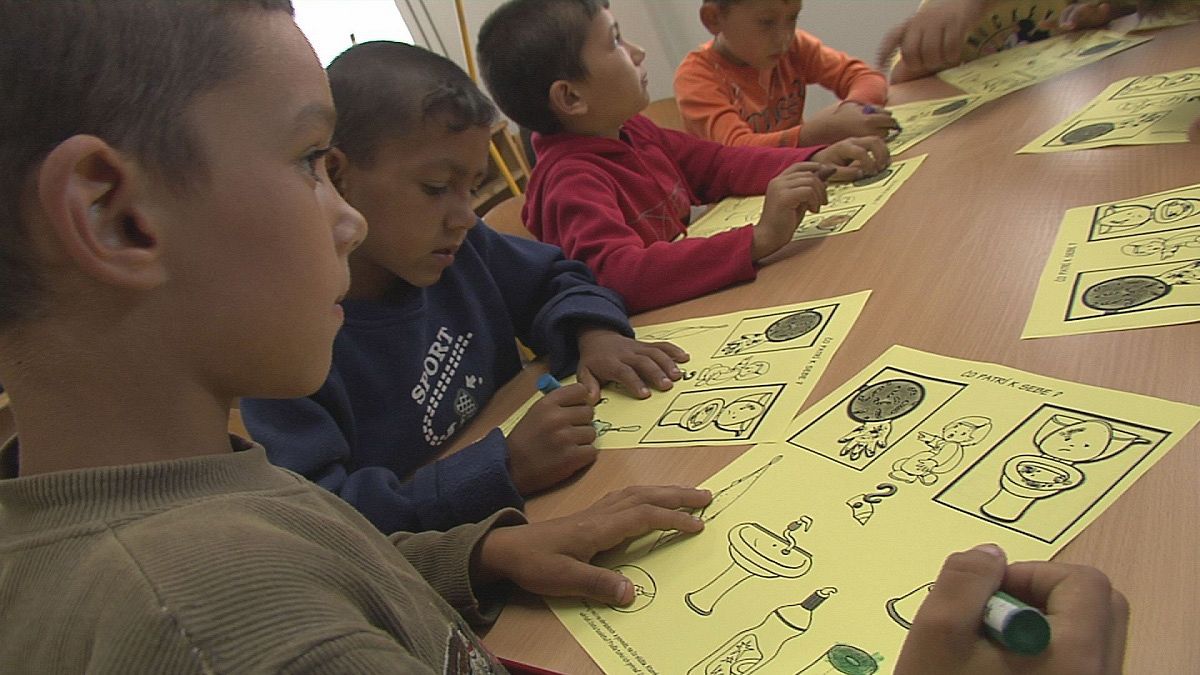“In our school integration and inclusion happen every day. One way is to have Roma language as a working language among children. I think this is the way to integrate and we do it,” said English teacher Jana Luptakova.
Euronews’ Monica Pinna reports: “Slovakia has one of the highest number of Roma in Europe. They represent around eight per cent of the population. Here their life expectation is 15 years lower than the national average. Only 28 percent of children attend high school and around 20 percent of Roma men are employed”.
We went to the ghetto of Moldava nad Bodvou, about 25 kilometres south west of Košice. Families survive on government benefits. Of the 750 people who live here, 420 are children – each worth 22 euros a month.
Some residents live in houses with water and electricity and pay rent to the government. For the rest – illegal huts with no water, no electricity and no sewage system. And Moldava is not an exception.
The latest survey on the Roma community dates back to 2004. It listed more than 100 “segregated settlements” only in the region of Košice (koshisay). At a national level the number nearly tripled.
In Moldava nad Bodvou kids have to walk about two kilometres to reach the nearest school, Despite the distance, enrollment is high – social benefits for parents are determined by their child’s attendance.
The problems with the Slovak education system start during pre-school education.
Michaela Csalova, from the Centre for Sustainable Development Slovakia (ETP)-ENGL, said: “The problem is that they are not placed in the kindergartens, where they could learn basic hygienic habits, discipline, and then the first grade at the elementary school would be much easier for them, but they a re not accepted in the kindergartens here in Moldava”.
This is why the Centre for Sustainable Development, ETP, has organised pre-school classes to integrate Roma children into Primary school. These lessons are crucial for their development, as a large percentage are still being placed in special schools for mentally disabled, or all-Roma classes. This creates a profound disadvantage, according to experts and parents.
“Roma children don’t have the same opportunities as non-Roma kids because it’s difficult for them to go to school. It’s difficult for them to speak read and write in Slovak. But also Roma parents should make an effort to encourage children to go on studying,” said mother Alžběta Dudyová.
Euronews reporter Monica Pinna said:“A project in 2008 showed that integration is possible. The students at a school in Kremnica experience it every day”.
Kremnica, in the heart of Slovakia, has about 300 Roma residents over a population of 5,200 people. Here, the private secondary school Zefyrin Jiménez Malla is open to Roma and non Roma children and it’s specialized in preparing marginalized students for academic education.
“In this school, children, Roma and non Roma are educated in Slovak language, English and also in Roma language. They also have Roma history as a subject, and I think this is the good way forward for integration and this is specific of this school. I have never done this kind of work before, even though I am a Roma person,” said English teacher Jana Luptakova.
For some of Jana’s 5th year students, a mixed class is a totally new experience. Seventeen-year-old Nicola Pokošová, has spent all her previous school years in an only-Roma school. The change wasn’t easy.
She said: “At the beginning there were some looks that made me feel weird. I had to build relations. I thought I would have been rejected, but it’s not true. They (non-Roma) are normal and we became friends”.
This school offers children a place to learn and play. After school activities include art and music – they are encouraged to develop their personal talents. Students are given opportunities and equal access to quality education.
School Director, Jana Tomova, said: “Our goal is educating Roma children in mainstream education. Because usually Roma kids are placed in special schools where they can get only to the equivalent of four years education in nine years. Which is not economically viable”.
Improving the Roma situation has become a social and economic priority for the whole of Europe. The integration of Roma children and youth was high on the agenda during the latest European Platform for Roma Inclusion last June. The European Commission published a “progress report” that pushed Member States to implement their national Roma integration plans.
National and European coordination is key to solving a complex problem according Jàn Hero – the former head of Zefyrin Jiménez Malla. He is now working on a Roma integration for the Slovak Government.
He said: “Education shouldn’t stand alone. To solve the problem you also have to tackle housing, employment and health. It’s important to remove these obstacles for access to education. These barriers come from the family, from the Roma community and from society”.
Discrimination and unequal access to education will continue the cycle of poverty within the Roma community unless these barriers are broken.


